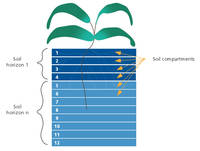A Quantitative modeling approach to soil assessment
Specific major soil factors have been studied in detail and field tested with specific crops under controlled conditions. This concerns mainly soil moisture and plant nutrients in the soil. The advantage of these quantitative methods is that they are more quantitative and less arbitrary than the parametric methods. The difficulty often is that these models are crop specific (they are only available for a limited number of crops) and their generally high demand for soil parameters that are not always available from routine soil investigations.
Modeling approaches for soil moisture availability
AQUACROP for instance estimates crop biomass and yield that can be expected under inadequate water availability in a given environment in a particular region. The water content in the root zone is simulated by keeping track of incoming and outgoing water fluxes at its boundaries.
Modeling flows in watersheds SWAT
SWAT - the Soil and Water Assessment Tool is a small watershed to river basin-scale model to simulate the quality and quantity of surface and ground water and predict the environmental impact of land use, land management practices, and climate change. SWAT is widely used in assessing soil erosion prevention and control, non-point source pollution control and regional management in watersheds.
Modeling approaches for nutrient availability
For instance the QUEFTS model (QUantitative Evaluation of the Fertility of Tropical Soils - Janssen et al., 1990), which predicts crop yields from chemical soil characteristics, as an indicator of soil fertility. Also the WOFOST model has a nutrient module.
Modeling approaches for specific crops
One example out of many: the model ORYZA2000 (Version 2.12, 2004), simulates the growth, development and water balance of rice under conditions of potential production, water limitations, and nitrogen limitations.

